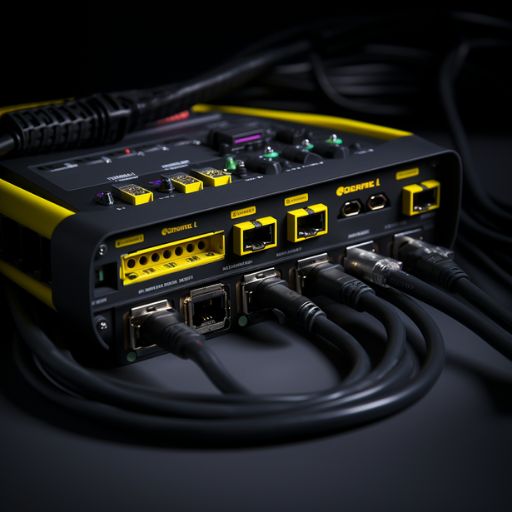Introduction
KVM switches, or Keyboard, Video, and Mouse switches, are hardware devices that allow users to control multiple computers from one set of keyboard, video monitor, and mouse. Their primary function is to streamline the management of multiple computers, whether in a home office or a large data center. This article will delve into the technical aspects of KVM switches, explaining how they work and the benefits they offer.
What are KVM Switches?
A KVM switch is a device that allows a user to control multiple computers from a single keyboard, video monitor, and mouse. This can be particularly useful in environments where space or resources are limited, such as in data centers, server rooms, or even home offices with multiple machines. The switch can be operated manually or through software.
How do KVM Switches Work?
KVM switches work by connecting the keyboard, video display, and mouse to the switch’s console ports. The computers are then connected to the switch’s other ports. When a user selects a specific computer, the switch routes the keyboard, video, and mouse signals to that computer, allowing the user to interact with it as if they were directly connected.
Benefits of KVM Switches
One of the main benefits of KVM switches is that they save space and reduce clutter by eliminating the need for multiple keyboards, monitors, and mice. They also save time, as users can switch between computers quickly and easily without having to physically move or reconfigure cables. Additionally, KVM switches can provide cost savings, as they reduce the need for additional hardware.
In the following sections, we will explore some popular KVM switches in the market, their features, and how they can benefit users.
How KVM Switches Work
A KVM switch (Keyboard, Video, Mouse) is a hardware device that allows a user to control multiple computers from one or more sets of keyboards, video monitors, and mice. Although multiple computers are connected to the KVM, typically, only one computer at a time can be controlled.
These switches are commonly used in data centers where multiple servers are placed in a single rack with a single keyboard, monitor, and mouse. A KVM switch then allows data center personnel to connect to any server in the rack. A common example of a KVM switch is the USB 3.0 Switch Selector by Rytaki.
Technically, KVM switches are a form of port replicator. They allow the use of one keyboard, monitor, and mouse (the “console”) to control multiple computers as if each were directly connected to the console. The switch then allows the user to switch control between the computers by pressing a button, using a software command, or using a combination of keystrokes.
Most KVM switches also support audio and USB devices. This means that you can share USB devices like printers or thumb drives between computers. Some KVM switches also support digital video signals, which can be useful if you have a high-resolution monitor
For more information on KVM switches, check out our KVM Switches category on ProductPickr.
Benefits of KVM Switches
Using KVM Switches can offer a multitude of benefits for both personal and professional use. Here are some of the key advantages:
- Space Saving: KVM switches allow you to control multiple computers from one keyboard, monitor, and mouse, reducing the need for additional hardware and saving valuable desk space.
- Cost-Effective: By reducing the need for additional hardware, KVM switches can save money in the long run.
- Increased Productivity: KVM switches allow for seamless switching between computers, making multitasking more efficient.
- Improved Organization: By reducing the clutter of multiple keyboards, monitors, and mice, KVM switches can help keep your workspace tidy and organized.
- Easy Installation: Most KVM switches are plug-and-play devices, meaning they require no additional software to install and use.
- Compatibility: KVM switches are compatible with a wide range of operating systems, including Windows, Mac, Linux, and more.
- High Resolution Support: Many KVM switches support high-resolution displays, ensuring a clear and crisp visual experience.
Whether you’re a professional looking to streamline your workspace or a home user wanting to manage multiple computers more efficiently, KVM switches offer a practical and cost-effective solution.
Choosing the Right KVM Switch
When it comes to choosing the right KVM Switch, there are several factors to consider. These include the number of devices to be connected, compatibility, and price. Here are some tips to help you make the right choice.
Number of Devices to be Connected
The first thing to consider is the number of devices you need to connect. KVM switches come in different sizes, ranging from those that can connect two devices to those that can connect up to 32 devices. For example, the USB 3.0 Switch Selector allows 2 computers to share 4 USB devices, while the RIJER 8 Port Manual Smart VGA USB KVM Switch can connect up to 8 PCs.
Compatibility
Another important factor is compatibility. Ensure that the KVM switch you choose is compatible with your devices and operating system. Most KVM switches are compatible with Windows, Mac, Linux, and Chrome OS. For instance, the AAO 2X1 KVM Switch HDMI 4K supports a wide range of systems including Windows, Mac, Linux, Unix, and more.
Price
Price is also a crucial factor. KVM switches can range in price from affordable to quite expensive, depending on their features and capabilities. For example, the Duttek 2-Port VGA Switch is priced at $18, while the IOGEAR 2-Port Dual View Dual Link DVI KVMP Switch is priced at $144.99. It’s important to balance your budget with your specific needs when choosing a KVM switch.
In conclusion, when choosing a KVM switch, consider the number of devices you need to connect, the compatibility of the switch with your devices and operating system, and your budget. By considering these factors, you can find a KVM switch that meets your specific needs.
About productpickr.com
Productpickr.com is a comprehensive platform that offers detailed information about a wide range of products. It serves as a reliable source for consumers seeking in-depth knowledge about various items, including KVM switches. The platform is designed to help users make informed decisions by providing them with accurate and up-to-date product information. However, it is important to note that the platform does not discuss any specific products, but rather provides general information about the product categories.
HTML Table
Below is a table that provides a general overview of the features and descriptions of KVM switches. KVM switches are a type of hardware device that allows users to control multiple computers from one keyboard, video monitor, and mouse. They are commonly used in data centers where multiple servers are placed in a single rack with a single keyboard, monitor, and mouse.
| Feature | Description |
|---|---|
| USB 3.0 Switch | This feature allows 2 computers to share 4 USB devices, such as a printer, scanner, mouse, keyboard, and another USB device. It’s plug and play, with no need to plug and unplug cables, and allows for one keypress to switch within one second. |
| Button Switch and LED Indicator | Users can easily switch between systems via a push button, and an LED can indicate the working computer. |
| Super Speed | The USB 3.0 switch hub makes the data transferring rate up to 5Gb/s (10 times faster than USB 2.0). It is backward compatible with USB 2.0 and USB 1.1 devices. |
| Stable Connection | Built-in Micro USB port for power supply if needed. When you need to connect more devices of high power consumption such as HDD, Printer, and Scanner, you should power it through the port via a power adapter. |
| Great Compatibility | This KVM switch is compatible with Windows 10/8/8.1/7/Vista/XP and Mac, Linux, and Chrome OS. It’s great for use at the office and home if you have multiple computers. No Driver needed. |
For more information about KVM switches, please visit our KVM Switches category page.
Link to Existing Posts
Here are some existing posts related to KVM switches:
- USB 3.0 Switch Selector,4 Ports USB 3.0 KVM Switch hub Sharing Switcher Box for Mouse, Keyboard, Printer, Scanner with One Switch Button and 2 Pcs USB A to A Cable – This USB 3.0 switch selector allows 2 computers to share 4 USB devices. It’s plug and play, with one keypress to switch within one second.
- Duttek 2-Port VGA Switch 2 in 1 Out for PC or Monitor Sharing or Switching – This switch allows for quick and easy switching between VGA sources via front panel pushbuttons. It supports VGA resolutions up to full HD 1920×1080 and WUXGA 1920×1440.
- AAO 2X1 KVM Switch HDMI 4K 2 Port USB KVM Switch Box Supports Auto-scan, Hot-Key Switch for Netware, Dos, Linux, Unix and Windows 4K@30Hz with 2 Pcs 5ft USB Cables and HDMI Cables Gray – This KVM switch supports wireless input devices and two switch modes between two PCs. It also supports full HD 4K visual enjoyment.
- 2 Ports VGA Switch Selector Box (2 In 1 Out, 2 PC to 1 Monitor) – This switch enables two computers to share one monitor or projector and two DVDs with VGA port to share one monitor, LCD or Plasma TV Set.
- Tek Republic TUS-200 USB Sharing Switch – 2 Port Manual Switch One USB Device/Hub Between Two Computers – This switch allows for easy one-touch manual switching of a USB device or hub between two computers.












